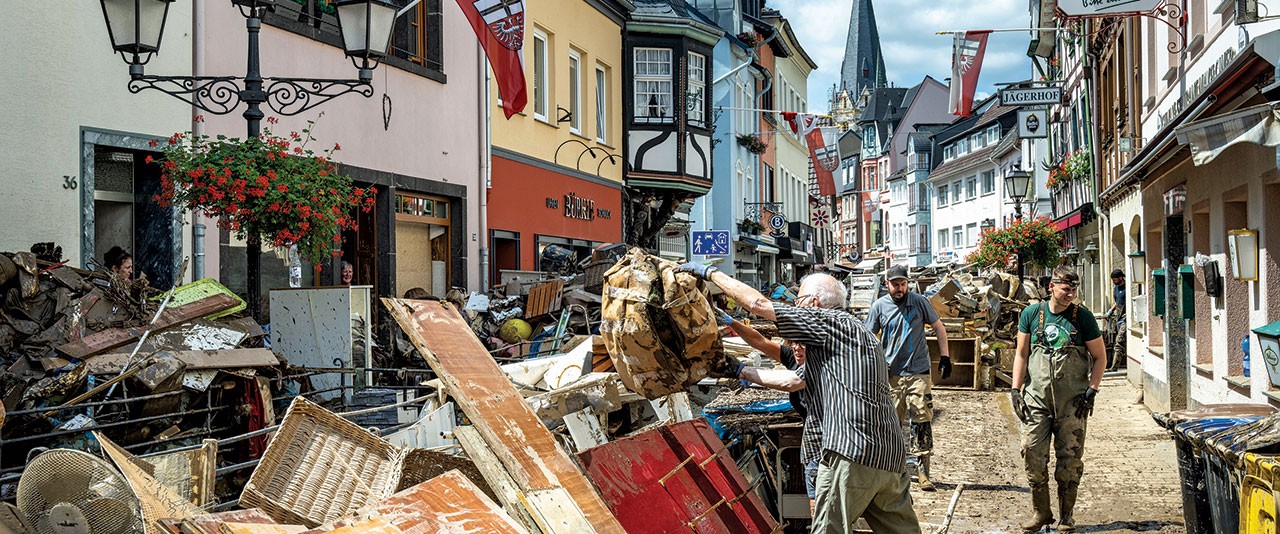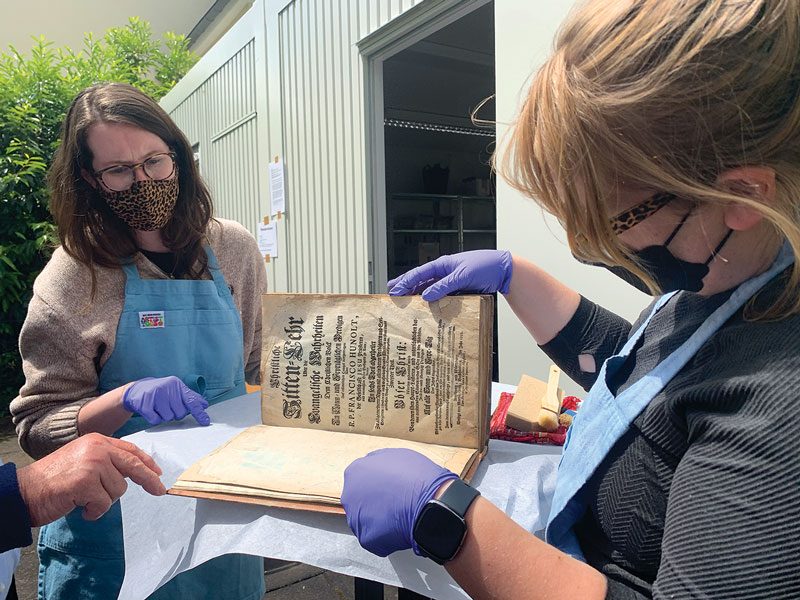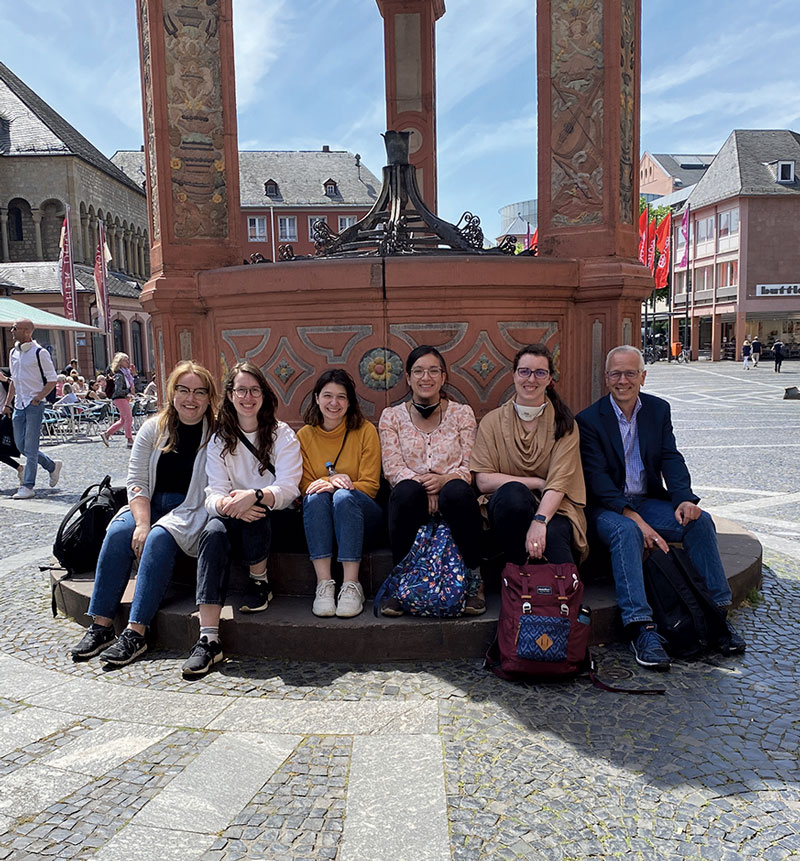


Over troubled waters
Ravaged by a flood, a German town finds restoration in Blue Hen expertise
April 13, 2023
As a child, Martin Brueckner played in castles and marveled at sunsets from a lush hillside. Such was life in Ahrweiler, a medieval German town that’s still partly ensconced by a moat and wholly surrounded by a stone ring wall reminiscent of Disney’s Beauty and the Beast. If Brueckner was ever late for school, he could blame the holdup on windy roads and rickety tractors that transported—slowly—large vats of blue-skinned grapes for area winemakers. Decades later, the University of Delaware professor can easily conjure the tangy, earthy, fragrant smell of the vineyards.
In August, 2021, an unprecedented flood 26-feet high ravaged this dreamy hamlet and consumed the valley where Ahrweiler sits. More than 130 died. Survivors processed a nightmare scene from third-story windows of terraced homes. Bridges collapsed, cars whipped around like paper airplanes and a six-foot pile of debris snaked its way through cobblestone streets.
Brueckner’s childhood home suffered damage beyond repair—water rose to the roof. His parents and brothers, still based in the German valley, escaped the worst of the flooding, but, like thousands of residents, they experienced gas and electrical outages that would last months.
He knew he had to act. As the director of UD’s Winterthur Program in American Material Culture, Brueckner studies the ways human beings engage with their objects—the way we shape them and, in turn, the way they shape us. So he knew, secondary to the loss of life, people in his home valley were set to grieve the loss of cultural goods—not just those with monetary value, but those items with historical and personal significance. Brueckner further knew, because his role interacts closely with The Winterthur/UD Program in Art Conservation, otherwise known as WUDPAC, he had access to considerable recovery and preservation expertise.
“The people of the Ahr Valley got clobbered, and the shock to their lives was horrific,” he says. “I thought to myself: If we don’t step in, who will?”
With the full support of his department administrators, Brueckner sent an email to the government officials of his hometown with one pleading message: How can I help?

Dirty work
Nearly 4,000 thousand miles away, Heike Wernz-Kaiser asked herself the same.
As curator of the White Tower museum, located in a 13th-century building that once housed an order of Catholic priests, she served a mission that might also be called spiritual: preserving the history and culture of the Ahr Valley. Some pieces in her collection dated as far back as 600 B.C.
When the floodwaters surged, there would be no divine intervention. But with the help of the so-called kulturgutrettern, a triage team who work to protect cultural assets in Germany, Wernz-Kaiser and colleagues swooped in to pluck what they could—approximately 30-40% of the collection—from murky water and goopy mud. For months, the group powered through heartbreak and tedium to dry, clean and restore paintings, sculptures, drawings, prints and other items. But they couldn’t do it alone.
Just as morale began to wane, Brueckner’s offer of help finally made it through bureaucratic channels and into the gloved hands of Wernz-Kaiser. By the end of May, 2022, the UD professor and a team of four graduate students (plus a recent alumna who offered her expertise) found themselves deep within the Ahr Valley, the mighty Rhine River to their east and the Volcanic Eifel mountains to their west. Waiting inside two jobsite trailers secured by the White Tower specifically for this Blue Hen team sat the history of this place and its people, reduced to a pile of musty crates.
Brueckner and the students set up one station for each category of artifact—metals, textiles, glassware, ceramics—and they spent one week scraping, rubbing, brushing and otherwise cleaning rust and caked-on mud from around 100 items. The work required gloves, masks and a range of unlikely tools: dental instruments, Korean beauty products.
“Because we are such a small field, rarely do we have instruments made specifically for us, so we beg and borrow from other fields,” says Allison Kelley, AS22M, one of the participating WUDPAC students. “In conservation, the name of the game is finding the thing that works.”
With a handmade bamboo skewer/cotton swab combo, Kelley spent two painstaking days chipping away at the dirt and waxy corrosion of a 19th-century candlestick. Others used cosmetic sponges on the ceramic mugs that would have been 19th-century souvenirs from one of many regional spas, famous then and now for the healing, mineral-rich water that naturally springs from this earth. For clothing, like a 19th-century tennis dress, the students employed a specialty vacuum for filtering mold spores. Between this restoration work, the team conceived of a new cataloging system, since the museum’s paper archive had been lost to the water.
Ask the students to describe this whirlwind of an experience, and they will tell you the work is what they’d hoped for and expected: a boots-on-the-ground opportunity to put years of classroom learning and theory into practice. What they didn’t anticipate? The emotional impact their trip would have on a community in mourning—and, ultimately, on themselves.
Says Wernz-Kaiser: “The solidarity from Delaware has given us the strength and endurance to continue fighting.”

A space for healing
Here’s the thing about tragedies de jour: When the news eventually recedes from public consciousness like water, only survivors are left to grapple with the fallout.
Nearly a year post-flood, long after the last television crew and relief worker had packed up and gone, the UD team encountered what Brueckner calls an “intensely bizarre landscape:” homes stripped down to their bones, businesses attempting to reopen amidst the rubble, residents enduring a period of interminable waiting—waiting for insurance payments to come through, for chaos to settle, for a sign from the outside world that their suffering had not been forgotten.
The latter, at least, the UD students could provide.
In a series of pop-up clinics, the Blue Hens invited residents of Ahrweiler and surrounding villages to bring their damaged personal items for expert advice on how to salvage them. With Brueckner serving as translator, the locals poured in, carrying muddied sentimental objects ranging from family albums to paintings of exotic fruit. One woman choked up when the students helped her uncover a photo of her late father. Another, a widow, asked for help with her ceramic plates, a cherished gift from her wedding day. And one gentleman gingerly carried a 17th-century book that had been handed down to him by a beloved relative, and which he hoped to gift his own grandchildren someday.
The items appeared fairly ordinary—nothing particularly exhibition-worthy or valuable. And yet, as cultural representations of what this community has endured, they became a launchpad for fulfilling a deeper human need: sharing—and processing—grief.
“People used their objects to say: ‘Look at this; look at what my family treasures have survived; look at what I have survived’,” says Maddie Cooper, AS15, TK21, preventive conservator at Philadelphia’s Conservation Center for Art and Historic Artifacts. “It was nice to offer guidance on preserving these heirlooms, but even more important was listening and acknowledging that trauma. We were able to tell them: ‘These things that tell your story, that you care so much about? We care about them, too.’ In this way, cultural preservation after a disaster helps build resilience.”
But it wasn’t just the townspeople who benefited from this work. Humbled by the trust placed in them over the course of the week, the Blue Hens also gleaned new perspectives on their craft.
“As stewards of material things, we have to remember the human stories,” Kelley says. “We can’t be some secretive group stowed away in labs or basements. You might spend an entire career studying priceless artifacts in a museum. But the things in a home—the objects that tell the story of who we are—are just as important.
“I do think these clinics were a bit of therapy for the people who came,” she adds. “And maybe for us, too.”
Looking forward
At this moment in Ahrweiler, there sits a Madonna statue smeared with mud that no one wanted to remove. That religious artifact will remain purposefully dirty, serving as a reminder of what happened to this town, its resilience and resolve to ensure such tragedy does not happen again.
And therein lies one of the great challenges of disaster recovery: When a mud stain or patch of rust becomes part of an object’s story, should it remain? The question can, at times, pit art conservationists (who seek to preserve the structural integrity of an artifact) against material cultural professionals (who assign new meaning to objects based on their breaks and blemishes).
Emily Bach, AS22M, was a material culture student at the time of the trip, which she calls “a surreal experience, an honor and a privilege.” Part of what drew her to the mission—and what she’ll take with her in her new career as associate registrar for the Maryland Center for History and Culture—is an unlikely collaboration between these seemingly diametric ideologies.
From her time in Germany, Bach recalls an early 20th-century cloth utensil holder whose utensils went missing… but not before the floodwaters permanently etched a rusty outline of their shape. The treatment plan for the object represented a compromise of sorts between culture and conservation: a little preliminary cleaning, but nothing to remove that shadowy reminder of the disaster.
Today, all of Ahrweiler grapples with these same questions: How much of the past can you afford to hold onto? How much can you afford to let go? Has all the damage been in vain, or might it be imbued with meaning? Can you mend what’s broken? Should you?
UD’s effort to help provide answers, at least in some small way, reinvigorated support for Ahrweiler from outside agencies, including Germany’s Cologne University of Applied Sciences, who will send experts from its own conservation program to pick up where the Blue Hen team left off. The trip also inspired ongoing discussions on UD’s campus about ways to facilitate future disaster recovery trips, given the increasing need for this type of work in the face of a changing climate.
But even after the world inevitably moves on to the next headline-grabbing event, residents of Ahrweiler past and present will continue rebuilding and remembering, Brueckner among them. During his recent visit, he once again climbed the rugged hillside where he did so much exploring as a child, and he gazed upon the fields and church spires of the place that raised him. He is under no illusions: This town will never be the same. But, breathing deep, he could still detect Ahrweiler’s unmistakable scent in the air: tangy, earthy, fragrant.
The smell of home.
Contact Us
Have a UDaily story idea?
Contact us at ocm@udel.edu
Members of the press
Contact us at 302-831-NEWS or visit the Media Relations website


